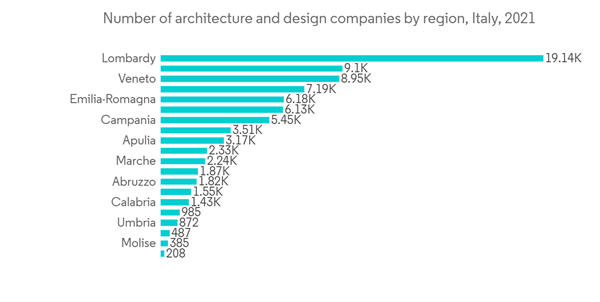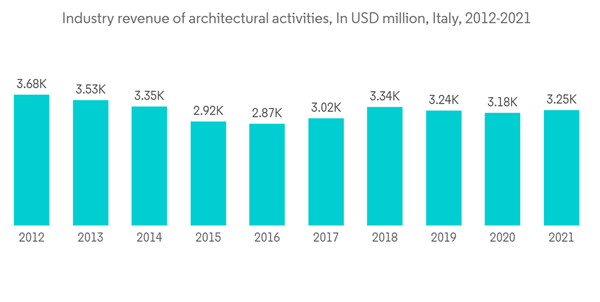Key Highlights
- Some of the main things that are expected to drive the growth of the Italian facade market over the next few years are a rapidly growing population, a growing construction industry, and more fires.The numerous advantages that facades provide in passive cooling, creating low solar penetration energy-efficient buildings, lowering air conditioning expenses, and reducing overheating are also expected to boost the country's facade market over the forecast period.
- Facade products are likely to be used more in commercial buildings, stadiums, retail stores, airports, warehouses, medical centers, garages, and hotels because of their benefits, such as less air and vapor leakage, better thermal insulation, and a longer life cycle for infrastructure.This is expected to further accelerate the market's growth. Additionally, rising demand for entirely recyclable facade boards, along with increased awareness of energy-efficient buildings and zero emissions, is anticipated to fuel market expansion for facade products.
Italy Facade Market Trends
Facade as An Environmental Architecture Propelling Market Growth in Italy
- From erection until demolition, a structure uses a total of 15% of its energy for construction, with the remaining 80% going toward operation. Over the past few decades, people's views on how they use energy and the environment have changed, and now this is seen as a natural part of Italian design.However, it is not always clear whether to design the facade with a transparent shell. The double-glazed facade claims that energy conservation is a priority and fits very well with this new way of thinking.
- From an energy use point of view, there is no reason to have similar facades facing different directions.On the other hand, the design might depend on which direction the facade faces on the compass. The south facade in Italy is ideal for utilizing solar heat using double-glazing and solar panels, where the gaps are employed for ventilation, heat collection, and protection for blinding purposes.
- For a more traditional look, the side of the house that faces north can have smaller windows and more insulation.In the summer, the west and east facades may get too hot because the angles of incidence are lower in the winter and passive solar gains are low.As a result, these orientations need to be handled with extreme caution. According to the building's location in Italy, the architecture happens to be more environmentally sensitive. If the location permits, double-layer glazing can be built with a function in between any number of facades that face either east or west.
- As the number of architecture and design companies in Italy is growing rapidly with each passing day, most of the industry innovators are changing their perceptions towards a greener economy with the above-mentioned designs, giving Facade an Environmental Architecture tag with their construction activities in Italy.
Italian Facade Market Is Expanding with Rainscreen System and Cladding
- The term "rainscreen" refers to the weather-resistant cladding on the outside of a building that is set back from the building's outer wall barrier and has an air space below it.Any moisture that seeps through the coating is drained away. The rate at which any remaining moisture evaporates is accelerated by the free-flowing air between the wall and the cladding.
- For Italian designers, architects, and engineers who want to have improved moisture management and energy sufficiency from the exterior of building projects like facades, rain-screen has become the answer. The rainscreen mechanism cancels out the effects of air and water getting in by draining them away.Improved energy efficiency is the result of the additional outside insulation provided by the primary screen.
- The rainscreen's design limits any potential water leakage to the principal building envelope's barrier. As a result, the likelihood of water reaching the wall assembly is reduced. Additionally, rainscreens offer the buildings' exteriors limitless design options for mounting. Numerous cladding solutions, including ACM, fiber cement, UHPC-attached stone veneer, contemporary composites, and stucco, can be applied to the structure.
- Cladding, which is an exterior surface formed by components linked to the main structure but not a part of it, Insulation, fillers, membranes, brackets, gaskets, fixings, cavity barriers, flashing, and sealants make up the exterior layer of the Italian cladding system. The minimal security of cladding does not increase the structure's stability.However, it serves a structural purpose by transporting weight, impact, snow, and wind stresses to the primary framework of the structure.
- While incorporating such modern architectural designs into Italian buildings, the industry revenue of "architectural activities" in Italy has surpassed USD 3,000 million since 2018 and is expected to rise further in the coming years.
Italy Facade Industry Overview
The Italian facade market's competitive landscape is observed to be fragmented, with many local players operating in the market. Better insulation materials, double-skinned facades, and UPVC are used more often by facade manufacturers in Italy than other materials because they make buildings use less energy.Also, it is expected that the number of people doing business on the Italy market will grow a lot because of the introduction of advanced technologies like precast facade panels.In the Italian market, which is very competitive, builders and contractors are competing over how to use new building materials. Using materials that save energy in the facade and keeping the facade's strength and quality for a longer life are two examples of this element.Along with facade solutions, they offer a number of other services, such as retrofitting, maintenance and inspection, repairs and spare parts, remote assistance and hotline packages, and advice.In Italy, these options are often used in commercial settings to improve the look of buildings and protect the environment.
Some of the most important companies in the Italian facade market are Permasteelisa S.p.A., Ramboll Group A/S, Aghito Zambonini S.p.A., Bluesteel S.r.l., and CANTORI S.r.l.
Some other major players in the market are ITALGRANITI GROUP S.P.A., BEMO SYSTEMS GmbH, Zanetti Srl, Incide Engineering SRL, Focchi S.p.A., Bollinger+Grohmann Engineering S.R.L., Arup, Wienerberger, ALIVA S.r.l., Cosentino S.A., etc.
Additional Benefits:
- The market estimate (ME) sheet in Excel format
- 3 months of analyst support
This product will be delivered within 2 business days.
Table of Contents
Companies Mentioned (Partial List)
A selection of companies mentioned in this report includes, but is not limited to:
- Permasteelisa S.p.A.
- Ramboll Group A/S
- Aghito Zambonini S.p.a
- Bluesteel S.r.l.
- CANTORI S.r.l.
- ITALGRANITI GROUP S.P.A.
- BEMO SYSTEMS GmbH
- Zanetti Srl
- Incide Engineering SRL
- Focchi S.p.A.
- BOLLINGER+GROHMANN INGEGNERIA S.R.L.
- Arup
- Wienerberger
- ALIVA S.r.l.
- Cosentino S.A*
Methodology

LOADING...










